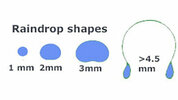
•How much does a raindrop weigh?
The term "heavy rain" is certainly not referencing its weight.An average raindrop weighs just 0.001 ounces (0.034 grams), according to the physics department at Union University in Tennessee. That’s less than an eyelash.
•It takes about 2 minutes for a raindrop to reach the ground
While the height at which raindrops fall from the clouds varies, they descend toward the ground at an average speed of 14 mph, according to the United Kingdom’s Met Office.If we assume the clouds are located at an altitude of 2,500 feet, that means according to data it would take a raindrop just over 2 minutes to reach the surface.
The Met Office notes that larger raindrops can fall as fast as 20 mph, while the smallest raindrops might take up to 7 minutes to tumble toward the ground.
•There’s a spot on Earth that has never seen rain
The Atacama Desert in northern Chile and southern Peru is the driest spot on Earth based on meteorological observations. It averages only 0.019 inches (0.5 millimeters) of rainfall annually, according to Guinness World Records. NASA says it's the driest non-polar desert on the planet.•The rainiest place in the world is in India
Lastly, the seventh interesting fact about rain is Mawsynram, in India’s Maghalaya state, is the rainiest place on the planet. According to WorldAtlas.com, it averages 467.4 inches of rain annually.The Indian monsoons bring moist southwesterly winds off the Bay of Bengal. The winds bump into the Himalayas and are forced to rise up the mountains, which enhances the precipitation on the windward sides and drops enormous amounts of rainfall on the village of Mawsynram.
•Rain does not always reach the ground
When rain falls from the clouds, it usually reaches the ground and leaves you wet if you’re caught unprepared without an umbrella.But if the air is very dry, raindrops can evaporate during their ascent toward the Earth’s surface, so in terms of sensible weather, it would just be cloudy.
•What is the shape of a raindrop?
Raindrops are not actually shaped like teardrops. In fact, the most common raindrop is shaped more like a hamburger bun, according to the United States Geological Survey."Small raindrops (radius less than 1 millimeter) are spherical; larger ones assume a shape more like that of a hamburger bun," the USGS says. "When they get larger than a radius of about 4.5 millimeters, they rapidly become distorted into a shape rather like a parachute with a tube of water around the base – and then they break up into smaller drops."



